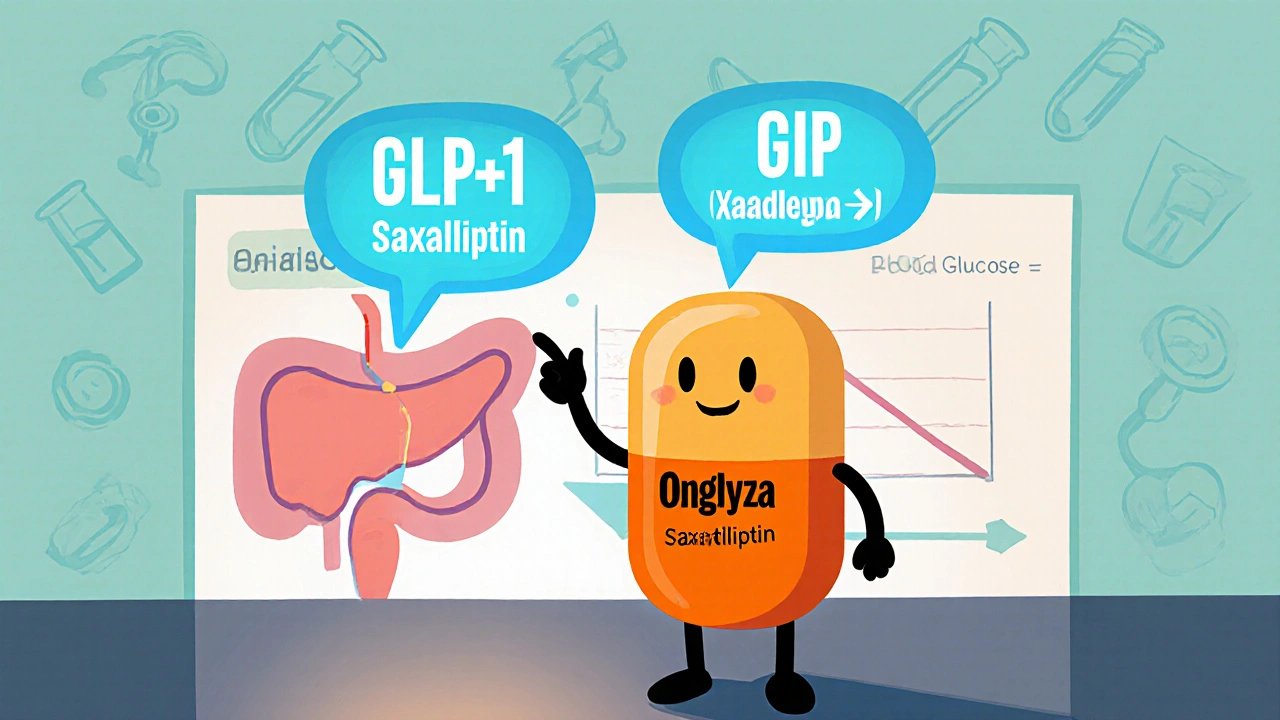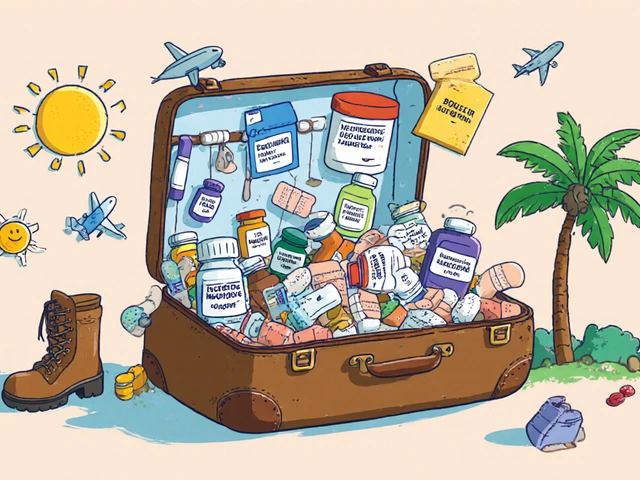Onglyza Dose Adjustment Calculator
Enter your kidney function value to see the appropriate Onglyza dosage recommendation.
Key Takeaways
- Onglyza (saxagliptin) is a once‑daily DPP‑4 inhibitor that lowers HbA1c by about 0.5‑0.8%.
- When compared with other oral agents, its cardiovascular safety is solid but it lacks the weight‑loss benefit of GLP‑1 agonists.
- Cost is higher than generic metformin but comparable to brand‑name DPP‑4 rivals such as Januvia.
- Kidney function matters - dose‑adjust for eGFR < 50 mL/min/1.73 m².
- Choosing the right drug hinges on A1C target, weight goals, heart‑failure risk, and insurance coverage.
What is Onglyza (Saxagliptin)?
When it comes to type 2 diabetes, Onglyza is a DPP‑4 inhibitor whose active ingredient is saxagliptin. It works by blocking the enzyme dipeptidyl‑peptidase‑4, which normally breaks down incretin hormones (GLP‑1 and GIP). By preserving these hormones, Onglyza boosts insulin release after meals and reduces glucagon output, leading to lower post‑prandial glucose.
Typical dosing is 5 mg taken orally once a day, with or without food. In clinical trials, the average reduction in glycated hemoglobin (HbA1c) was 0.5‑0.8 percentage points over 24 weeks.
How DPP‑4 Inhibitors Fit Into Diabetes Therapy
DPP‑4 inhibitors form a drug class that includes saxagliptin, sitagliptin, and linagliptin. They are usually added when metformin alone cannot achieve target A1C, or when patients cannot tolerate sulfonylureas. Their main advantages are low hypoglycemia risk and neutral effect on weight.
However, they are pricier than generic metformin and lack the proven cardiovascular mortality reduction seen with some SGLT2 inhibitors and GLP‑1 receptor agonists.
Top Oral Alternatives to Onglyza
- Sitagliptin (Januvia) - another DPP‑4 inhibitor, once‑daily 100 mg dose, slightly lower cost than Onglyza, similar efficacy.
- Linagliptin (Tradjenta) - DPP‑4 inhibitor that does not require dose adjustment in renal impairment.
- Dapagliflozin (Farxiga) - an SGLT2 inhibitor that lowers A1C by 0.6‑1.0%, promotes modest weight loss, and reduces heart‑failure hospitalization.
- Canagliflozin (Invokana) - SGLT2 inhibitor with similar glucose‑lowering effect but carries a higher risk of lower‑limb amputation in some patients.
- Metformin - first‑line biguanide, inexpensive, lowers A1C 1‑1.5%, may cause GI upset, contraindicated in severe renal disease.
Comparative Snapshot
| Drug (Brand) | Class | Typical Dose | HbA1c Reduction | Weight Effect | Cardiovascular Benefit | Average US Cost (30‑day supply) |
|---|---|---|---|---|---|---|
| Onglyza (Saxagliptin) | DPP‑4 inhibitor | 5 mg QD | 0.5‑0.8 % | Neutral | Neutral (no MACE reduction) | $320 |
| Januvia (Sitagliptin) | DPP‑4 inhibitor | 100 mg QD | 0.5‑0.7 % | Neutral | Neutral | $280 |
| Tradjenta (Linagliptin) | DPP‑4 inhibitor | 5 mg QD | 0.4‑0.6 % | Neutral | Neutral | $310 |
| Farxiga (Dapagliflozin) | SGLT2 inhibitor | 10 mg QD | 0.6‑1.0 % | ‑1.5 kg (average) | ↓ HF hospitalization | $350 |
| Invokana (Canagliflozin) | SGLT2 inhibitor | 100 mg QD | 0.6‑1.1 % | ‑1.8 kg | ↓ MACE, ↓ HF | $360 |
| Metformin (Glucophage) | Biguanide | 500‑1000 mg BID | 1.0‑1.5 % | Neutral or slight loss | Improves CV outcomes modestly | $5 (generic) |
Decision Factors: When to Pick Onglyza
- Renal function. If eGFR is between 30‑50 mL/min/1.73 m², reduce the dose to 2.5 mg daily; avoid if <30 mL/min.
- Hypoglycemia risk. Patients on sulfonylureas or insulin benefit from Onglyza’s low‑hypo profile.
- Weight concerns. If weight loss is a priority, an SGLT2 inhibitor or GLP‑1 agonist may be better.
- Cardiovascular history. Those with established ASCVD or heart‑failure should consider agents with proven CV benefit (e.g., dapagliflozin, empagliflozin, semaglutide).
- Insurance coverage. Check formulary tiers; Onglyza often lands on a higher co‑pay tier than generic metformin.

Practical Tips & Common Pitfalls
- Start with metformin unless contraindicated; add a DPP‑4 inhibitor like Onglyza only after assessing tolerability.
- Monitor renal labs at baseline and every 6‑12 months; dose‑adjust promptly.
- Watch for signs of pancreatitis (severe abdominal pain) - rare but reported with DPP‑4 inhibitors.
- Educate patients that Onglyza does not replace lifestyle changes; diet and exercise remain essential.
- Avoid concurrent use with strong CYP3A4 inhibitors (e.g., ketoconazole) that can raise saxagliptin levels.
Frequently Asked Questions
Can I take Onglyza together with metformin?
Yes. The most common regimen is metformin plus a DPP‑4 inhibitor. This combination improves A1C without increasing hypoglycemia risk.
What should I do if I miss a dose?
Take the missed tablet as soon as you remember, unless it’s almost time for the next dose. In that case, skip the missed one - don’t double‑dose.
Is Onglyza safe for people over 75 years old?
Clinical data show similar efficacy and safety in older adults, provided renal function is adequate. Dose‑adjust or choose an alternative if eGFR is low.
How does the cost of Onglyza compare to generic options?
Onglyza often costs $300‑$350 for a month’s supply, while generic metformin is under $10. Insurance coverage can narrow the gap, but it remains a premium drug.
Does Onglyza cause weight gain?
Weight change is generally neutral. If weight loss is a goal, consider an SGLT2 inhibitor or GLP‑1 receptor agonist instead.
Next Steps: Talk to Your Healthcare Provider
Before switching or adding Onglyza, schedule a medication review. Bring recent lab results (A1C, eGFR, liver enzymes) and a list of all current drugs. Use the comparison table to discuss cost, cardiovascular goals, and personal preferences. Remember, the best choice balances efficacy, safety, and affordability for your unique situation.







9 Comments
The DPP‑4 class, including Onglyza, offers modest HbA1c reduction without hypoglycemia risk, making it suitable when metformin alone fails.
Honestly the guide overstates the safety dta-there are hidden renal warnings that many docs ignore. Also the price point is absurd for most patients.
From a pharmacoeconomic standpoint, Onglyza's incremental cost‑effectiveness ratio is untenable; the marginal A1c decrement fails to justify its premium.
When considering Onglyza, the first thing to check is the patient's renal function because saxagliptin requires dose adjustment below an eGFR of 50.
If the eGFR is between 30 and 50, you should halve the dose to 2.5 mg daily to avoid accumulation.
For patients with eGFR above 50, the standard 5 mg once daily is appropriate and generally wel tolerated.
One of the advantages of DPP‑4 inhibitors, including Onglyza, is the low risk of hypoglycemia compared with sulfonylureas.
This makes them attractive for elderly patients who may have unpredictable meal patterns.
However, you should also weigh the lack of weight loss benefit; many patients prefer agents that at least modestly reduce weight.
If weight loss is a priority, an SGLT2 inhibitor like Farxiga could be a better fit, provided there are no contraindications.
Cost is another critical factor; Onglyza runs about $320 for a 30‑day supply, which is considerably higher than generic metformin.
Insurance coverage varies widely, so checking the formulary before prescribing can prevent unexpected out‑of‑pocket expenses.
From a cardiovascular perspective, Onglyza has a neutral profile-no proven reduction in major adverse cardiac events, unlike some SGLT2 agents.
That neutrality is still acceptable for patients without a high baseline heart‑failure risk.
If a patient has established heart failure, an SGLT2 inhibitor is generally preferred due to proven HF hospitalization reduction.
When you combine Onglyza with metformin, you often see additive A1c reductions approaching 1 % in practice.
But remember that metformin should be titrated slowly to minimize gastrointestinal side effects.
Monitoring for pancreatitis, though rare, is recommended, especially if the patient has a history of pancreatic disease.
Overall, the decision hinges on renal function, cardiovascular risk, weight goals, and, of course, the patient's insurance landscape.
Hey, I actually tried Onglyza myself for a few months and felt kinda meh-nothing crazy changed, but at least I didnt get any scary low sugars.
That’s awesome you gave it a shot! 😊 Most folks feel the same neutral vibe, and the brand’s price is kinda steep 😅 but still a solid add‑on if metformin isn’t enough. 👍
While the article outlines basic characteristics, it fails to address the crucial point that prescribing Onglyza without considering alternative agents is a negligent practice that could endanger patients.
Consider the eGFR before dosing – 🩺💊
I appreciate the thorough comparison; it helps clinicians match therapy to individual patient profiles in a clear, culturally sensitive way.